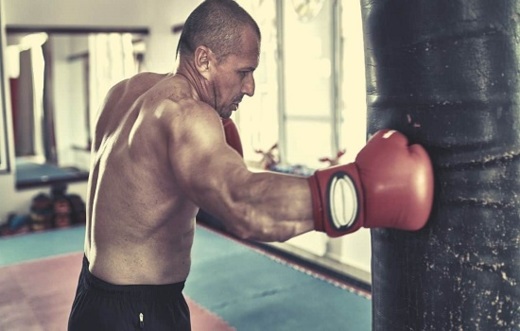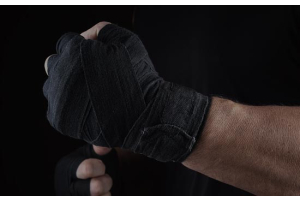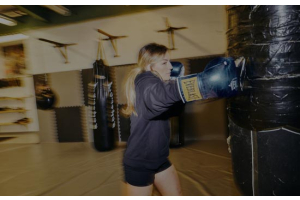Points to Remember For Heavy Bag Training

The heavy bag or a punching bag is one of the most fundamental and useful training equipment in a boxing gym and also in non-boxing gyms. Heavy bag presents you to exercise a large number of drills making your workouts more methodological and rigorous. Technical training on the heavy bag also inspires you to train tough and for a longer duration, helping you to master the art of boxing. When you are training with a heavy bag, it is better to keep your training in rounds according to your aim and personal capacity. You can use a round timer to monitor your rounds usually, a set of three minutes of workout and one-minute break is most suitable. If your workout intensity is high, then keep the rounds shorter, or if your body is not conditioned enough then start with the shorter round. If you adopt a set with low-intensity rounds then an active rest period is good and for high-intensity rounds, a passive break period is necessary. You also need to keep practicing your footwork drills along with heavy bag training. Keep toggling around the bag, take steps forwards and backward, pivots, and change stance. Try to condition your body to maintain a balanced stance while punching. To get a better understanding of heavy bag training, the drill is categorized into three major domains:
- Defense and Attack Round
- Attack Round
- Conditioning Round
Check out our Coaching Equipment!
To obtain a wide range of technical approaches, blend all these rounds into every workout rather than just focusing on a single category.
1. Attack Rounds
Attack rounds are focused to enhance your strength, endurance, speed, and movements.
• Head-Body-Head Levels
This training practices your different body levels and switching the levels. Start by launching a blow at head level then descend to body level strike and lastly few blows back at the head level. Go for the smooth and speedy shots. You may blend various shots and strikes. Practicing this technique would enable you to strike clean shots and make you resilient.
• Launching Hooks at Various Ranges
This round practice your range of hooks and switch them. Start with close range launch a few hooks with one hand and then change hands, keep a solid stance. Now switch to a medium-range, using both hands. Lastly, launch a long-range hook and strike a few blows.
• Jab Round
This round is essential as jab is the most fundamental punch in boxing and it must be a part of every heavy bag training. Begin with single strikes, then doubles, then triple, and quadruple jabs. Keep your foot movements along with punching, and utilize the following methods for variations:
- Keep changing your levels
- Introduce feints
- Try jabbing out and back quickly
- Use other combinations along with a jab
- Southpaw
Southpaw
Southpaw would help you find your weaknesses in your foot movement and footwork technique. It reduces strain in your feet and inculcates more speed while you switch your stance.
Body Shots
This set is based on the shots or attacks delivered to the torso. Start by launching direct body shots, then blend in some combos that end with a shot to the body. Try to launch the final body shot effectively and with full impact. Mix hooks and strikes to the body. Use your foot movement to pivot and change angles. For a final knock out aim for the liver shot.
Short Attack Combos
This round is usually best to keep at the start to let you warm up your basic techniques without thinking much. Keep the combos short and simple like; jab-cross, double jab-cross, jab-cross hook. This round gives you an opportunity to condition your fundamental attacks before moving to the advanced combos.
Focus on Punching With Balance
It is necessary to deliver your strikes along with maintaining your balance. You use footwork to balance if you lose your balanced stance but this round practices you to launch the blow with appropriate balance. You need to keep your footwork limited, determine your balance and keep the center of gravity. After developing the solid stance launch punch combos with the movement of the upper body and head.
Maintain Close Contact
Get in close touch with the heavy bag, make a contact in close range, stay tight, and throw short quick punches.
Shifting Your Body to The Right
It may not be easy to move to the right in the beginning. But this round would be advantageous for you in sparring sessions. Users of the southpaw will move to the left. You need to practice moving towards the right. Throw jabs while moving to the right, circle to right, and launch an attack combo.
2. Defense And Attack Rounds
These rounds are a combination of defensive training with attacks. They aim to augment your overall movement and defensive movements.
Block And Counter-Attack
Once you start, keep practicing a single technique first until you are smooth with it. For instance, begin with catch and jab. Catch an imaginary jab from a rival and counter with a combo. You can blend other attack combos as well along with defense. Remember always try to return with a fast response.
Dempsey Roll
It is a good workout for moving your head, it involves slipping in one direction with launching a wide hook in the same direction with the alternate hand. For instance, if you make a slip on the right side then you launch a hook to the left. While doing this your head would continuously move, making you a tough target to aim an attack for. Add the roll in other attack combos as well to keep bobbing your head.
Within Range And Out-Range Attack
It is aimed to work your defense and supplement it with quick attacks. Begin with out of range, then enter into range throw a speedy combo and return back to out of range. Leave your position, reset and enter with a different attack combination. Once you get used to this combo then go for ducking in, attacking, and then ducking out quickly.
Moving Head Between Attacks
It is a quite creative round, indulging your neck, shoulders, and abs. it targets to improve your head movement. Start with a head movement and then launch an attack. Then again introduce your head movement in the middle of a fight. A wonderful way to start a combo is a jab, slip to left, slip to right, and then straight.
3. Heavy Bag Conditioning
These training rounds in boxing will amplify your body fitness and conditioning. They are best for both fight and sparring sessions.
Deep Breathing And Relaxation
It is an essential round after an intensive training round, it will assist you to recover if you are still exhausted after the break period. It aims to target your breathing efficiency and relax your body rather than any attack combos. Make a combo of punches and move, take deep breaths, regain, and repeat. Take deep breaths between the combos and exhale through your nose. These round strengths your breathing during high-intensity training.
Low Strikes
Low drives targets legs for conditioning. It is focused on launching blows from a low stance. Bend your torso to get low, strike a blow, and then fall back keeping a balanced stance.
Punch-Out
This is the last-round workout that will help you imitate your final rounds in the sparring sessions. In this round focus on a quick launch of blows to keep the impact high rather than focusing on the technique. The basic punch-out constitutes sets of six shots minimum, but you can do up to ten shots. If you are new you can start with two sets and progressively move through 4,6, and 8.
Keynote: Heavy bag training is an essential part of martial art sports. The training through the heavy bags is best performed in sets with rounds that cover every aspect of your boxing training.
Want to learn more? Sign up for our NEWSLETTER below and start receiving more Tips & Info by E-Mail.





